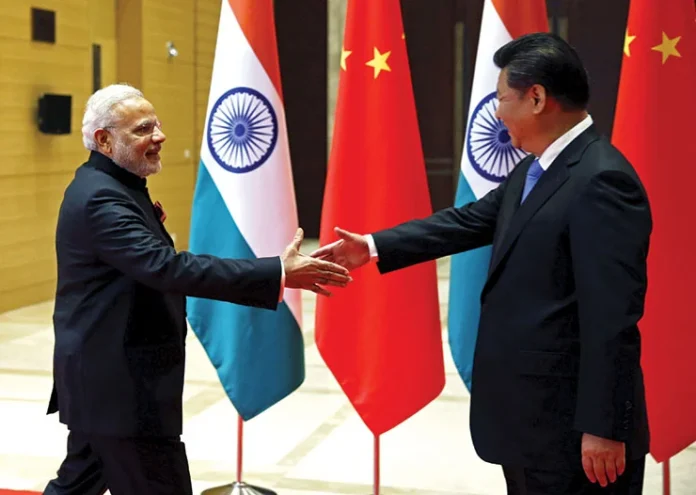India-China relations remained in focus last month, as a number of important events manifested the geo-political scenario that unfolded in quick succession. Display of solidarity and support could not be missed during Chinese President Xi Jinping’s visit to Moscow to meet his Russian counterpart Vladimir Putin in the backdrop of the on going Ukraine war, Japanese Prime Minister Fumio Kishida’s visit to New Delhi indicated the emphasis on Indo-Pacific and the Quad that lays stress on strategic cooperation between Australia, India, Japan and the United States, and the truce between Iran and Saudi Arabia caught everyone by surprise as they agreed to re-establish diplomatic ties and the mediation was accomplished by China.
If President Xi’s meeting with his Russian counterpart Putin showed that China is strongly supporting Russia over Ukraine, it puts India in a bind which has carried on with its nuanced stance and puts the onus on New Delhi to be clever in expanding its strategic outreach as it faces standoff on the border with China.
Over the past nearly three years since a clash at Galwan in Ladakh in June 2020 led to the deaths of 20 Indian and four Chinese soldiers, India and China have seen border tranquillity falling prey to tensions and skirmishes. In December 2022 a clash took place at Yangtse, northeast of Tawang in Arunachal Pradesh. Both sides are witnessing a painfully slow movement in easing their border tensions along the disputed 4,000-kilometre border. The earlier agreements of 1993, 1996, 2005 and 2013 between the two neighbours have literally been thrown to the winds as China prevents Indian soldiers from carrying out patrol duties along the border.
Since 2020 clash, several rounds of talks have been held between the two sides and disengagement has occurred at four points in Ladakh, but two sore points still remain unsettled. Normalcy in bilateral relations seems far away even as ministers and high-ranking officials of the two countries have had regular meetings. External Affairs Minister Dr S. Jaishankar has pointed out that there could be no normality in India-China relations until the situation in eastern Ladakh was resolved.
The latest move of China ‘renaming’ of areas in Arunachal Pradesh points to its machinations and marks a new low in its ties with India. Rightly so, India has summarily rejected China’s bid to lay claim over areas in Arunachal Pradesh. China’s attempt shows affront and scant regard for India’s territorial sovereignty. The Ministry of External Affairs said in a statement that ‘invented names’ will not alter the reality that Arunachal Pradesh is an integral part of India. The move by China came even as India was playing host to the visiting Bhutanese King Jigme Khesar Namgyel Wangchuck who held meetings in New Delhi with President Draupadi Murmu and Prime Minister Narendra Modi. Security and border issues, including theprogress on boundary talks between China and Bhutan, particularly above the tri-junction point of Doklam, where a flare up had occurred four years ago came up for discussions in these meetings.
Policy analysts have pointed out that despite high-level meetings between the two sides to pave the way for establishing peace on the Line of Actual Control, it is becoming clear that Beijing intends to maintain the status quo of an uneasy calm in the border areas. India will have to go deeper into analysing the move by China and its aggressive actions in order to counter its deceptive and false narrative to stoke trouble in newer areas in newer forms.
On many occasions in the recent past, China has made clear its strong dislike and disproval of Quad and Indo-Pacific strategic initiatives. Is it because China wants to deliver its message hard and clear that it disapproves India’s close strategic ties with the US? It wants to drive home the message that as a neighbour, Beijing would be more accessible to it in resolving problems and therefore this aggression along the LAC is a way to hammer its point.
For India, dealing with China remains a complicated web on account of a number of issues. India lags behind not only in military terms but also economically. In 2022, China’s GDP was nearly $18 trillion as compared to India’s $3.5 trillion. China’s Defence budget was nearly $230 billion, which is more than three times that of India’s.
India will have to figure out ways of what to do with its trade and business ties with China while finding ways to protect its strategic interests. It looks like a tough and long road ahead.
–The writer is a senior journalist and media consultant. The views expressed are of the writer and do not necessarily reflect the views of Raksha Anirveda
–The writer is a senior journalist based in Delhi. The views expressed are personal and do not necessarily reflect the views of Raksha Anirveda






